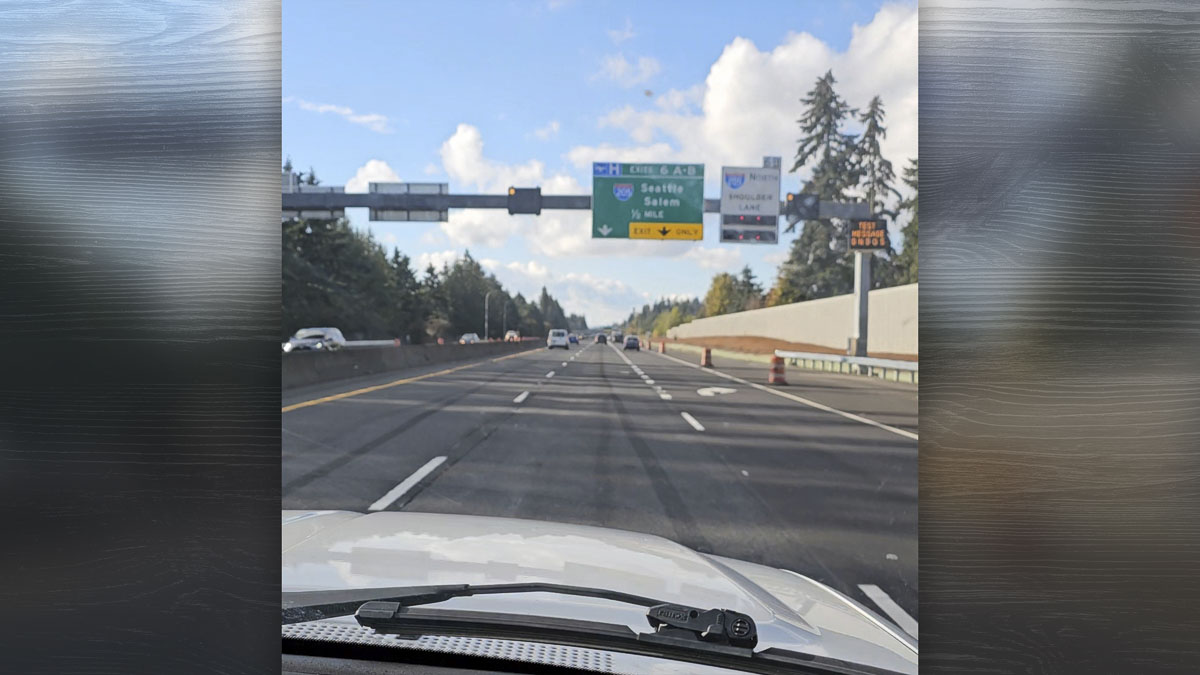
New lanes prove you can build your way out of traffic congestion
John Ley
For Clark County Today
The SR-14 lane expansion is essentially complete. The Washington State Department of Transportation (WSDOT) used $28 million to add two new lanes westbound and one new lane eastbound between 164th Ave. and the I-205 interchange. The change has been extremely beneficial for east Vancouver and east Clark County drivers.
Initial results show that the traffic congestion people have been dealing with for years, is now gone. Vehicle speeds are now fully back above the 50 mph highway speeds. Traffic congestion has decreased significantly. This demonstrates how adding vehicle capacity (new lanes) can reduce traffic congestion.
Multiple community surveys have shown saving time and reducing traffic congestion is people’s top priority. Yet when it comes to the I-5 Interstate Bridge Replacement Program (IBR), Administrator Greg Johnson regularly states “you can’t build your way out of traffic congestion.” He was proven wrong, with the completion of SR-14.
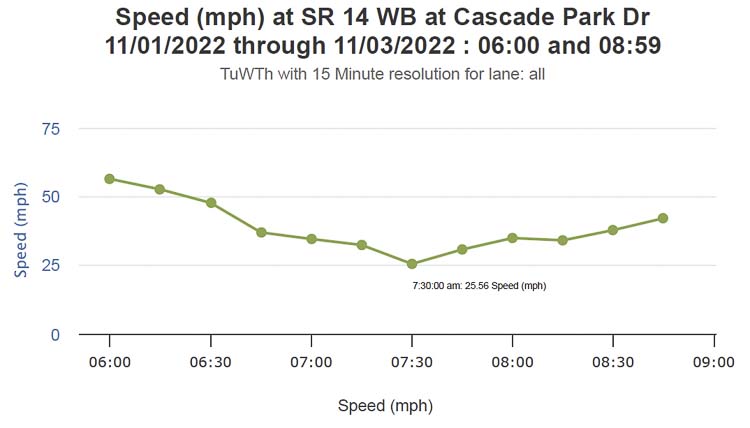
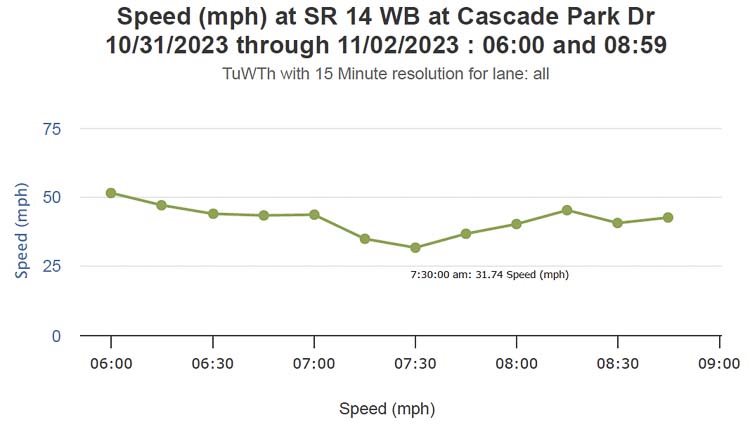
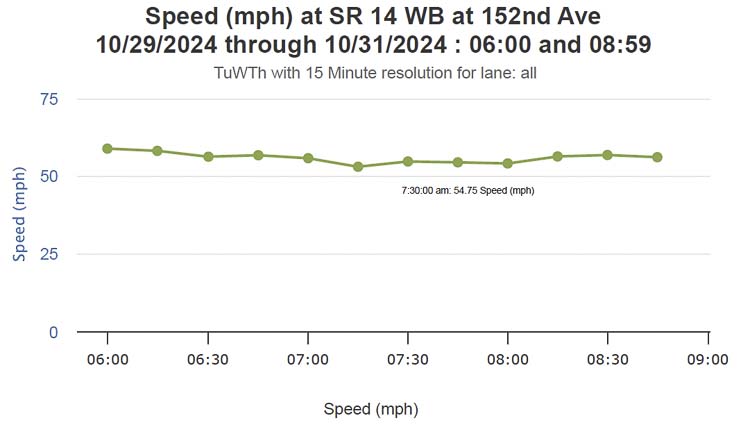
“State DOTs are fooling themselves if they think building more highways will cure congestion,” Roger Millar has been telling people since becoming head of the state’s Department of Transportation nine years ago. Yet during his tenure, the state has widened I-5 near Tacoma and near Joint Base Lewis McChord (JBLM), in addition to SR-14 and SR-502 in Clark County.
WSDOT provided Clark County Today three sets of data requested for 2022, 2023 and 2024 travel speeds on SR-14. The data show morning speeds slowed below 50 mph down to 25 mph around 7:30 a.m. in 2022. A year later, it slowed to about 31 mph. After project completion, SR-14 average speeds remained above 54 mph all morning.
“To accurately capture peak commuter timeframe, we use Tuesday, Wednesday, and Thursday,” a WSDOT official said. “Mondays and Fridays have too many variables in the data. Additionally for transparency, our Cascade Park data station located at milepost 7.72 was taken offline as part of the project in early 2024. It was replaced by a new station located at 152nd Ave milepost 7.90. This is why the 2024 graph shows a different location name.”
Other WSDOT & ODOT projects
Numerous other WSDOT projects are underway to reduce or eliminate traffic congestion.
Millar’s agency is currently working to complete the North Spokane Corridor. The first segment opened August 22, 2009 and is planned to be completed by December 2030.
Additionally, the JBLM project (Joint Base Lewis McChord) will widen seven miles of I-5 in Pierce County, from DuPont to Lakewood, adding an HOV lane in each direction. The proposed changes will reduce chronic traffic congestion through the JBLM corridor. The $233.3 million project is scheduled to be completed in 2026.
The addition of a new general purpose lane plus a new HOV lane on I-5 near Tacoma was labeled “magical” for the elimination of traffic congestion two years ago. “It was as if the Washington Department of Transportation (WSDOT) just snapped its fingers or waved a magic wand,” said one news report. “As soon as the new northbound lanes opened on June 26, the traffic just vanished.”
“There has been virtually no congestion from the corner by Highway 16 to Port of Tacoma Road ever since, and that includes a drive-through there Tuesday, July 5, in the middle of the afternoon,” reported KIRO’s Chris Sullivan. “I was shocked. I did not get below freeway speed on the day after a holiday when I would have normally been in a three-and-a-half mile, bumper-to-bumper mess.”
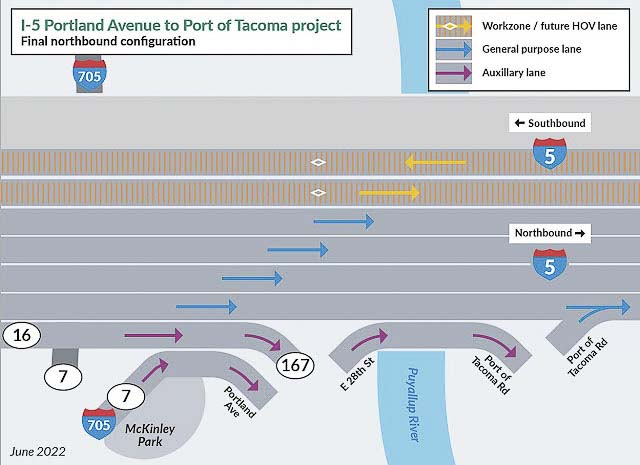
There are other examples locally. The Oregon Department of Transportation (ODOT) projected the addition of one lane in each direction on I-205 between the Abernethy Bridge and Stafford Road would eliminate 12 hours of traffic congestion.
“The analysis found that drivers could see a 50 percent decrease in afternoon travel time and a 25 percent decrease in the morning,” ODOT officials said. “In addition, travel times would become more reliable, and the number of crashes would shrink, improving efficiency and safety.”
That 7-mile I-205 lane extension project is now on hold due to ODOT running out of money for this and other transportation projects.
The Washington DOT can reduce congestion by making it easier for people to get around without a car and by encouraging off-peak commuting and telecommuting, Millar has said. Yet the reality is fewer people are using transit in both states.
“There is a new normal,” the Regional Transportation Council Board was told earlier this year. More people are working from home and using their private cars for recreation and errands, while transit ridership is down significantly. Staff see this as a permanent change.
The Cascade Policy Institute has reported various agencies have been trying to “get people out of their cars” for decades without much success. The Metro Regional Transportation Plan predicts that transit use will rise from 4 percent to 5 percent of trips by 2045, while walking and biking will remain flat. They further report the addition of a lane on I-5 between OR 217 and I-205 virtually eliminated several hours of congestion each day.
The Interstate Bridge replacement
The current “Modified Locally Preferred Alternative” for the Interstate Bridge Replacement Program (IBR) will replace an over congested three-lane bridge with another three-through lane bridge. The Draft Supplemental Environmental Impact Statement (DSEIS) reports traffic congestion will increase by over 30 percent by 2045.
Program documents report morning travel times will double, when traveling I-5 from Salmon Creek to the Fremont Bridge by 2045. After spending $7.5 billion, they also expect C-TRAN express buses will take 11 minutes longer to carry passengers into Portland, than if they had done nothing. The largest public works project in the history of the Portland metro area will make travel times much worse for both transit riders as well as freight haulers and people in their privately owned vehicles.
The IBR has options, where they could have added multiple auxiliary lanes to the 5-mile project corridor. This would improve travel times. Instead they will allocate 54 percent of the significantly wider bridge space to bikes, pedestrians, and transit. The project, if approved, will still have three through lanes, plus a single auxiliary lane.
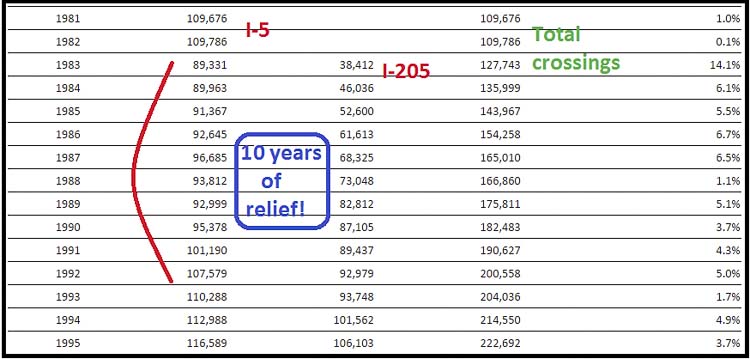
I-205 construction
In the 1970’s, Oregon and Washington decided to build a “ring road”, allowing freight haulers and cars to avoid I-5 and instead use a bypass to avoid the crowded inner core of Portland. The plan was to build the eastern half of the “ring”, followed by building a western bypass.
I-205 including the Glenn Jackson Bridge opened in December 1982. The Regional Transportation Council (RTC) shows data for both the I-5 and I-205 transportation corridors. The number of vehicles using the Interstate Bridge dropped by over 20,000 vehicles in 1983. It took a decade before the number of vehicles climbed back up to the 1982 number. Adding vehicle capacity worked.
Sadly, the planned construction of the westside bypass was killed by Portland politicians in the 1980’s. In 2017, Oregon Rep. Rich Vial offered a westside bypass to help relieve traffic congestion on US 26 which dumps the majority of Washington County traffic into downtown Portland, creating the state’s second worst bottleneck.
Vial was undeterred by pushback, saying a limited-access highway west of I-5 is needed. “Rush-hour congestion on I-5, U.S. 26 and OR 217 particularly rile commuters from Washington County as well as other areas of the Portland metro area and Southwest Washington” reported a 2017 local news article.
A year ago, ODOT released a new Westside Multimodal Improvements Study. Among a host of new mass transit proposals, including a new tunnel under the Willamette River, was a new westside bypass highway labeled the Northern Connector. It would connect US 26 to US 30 in Oregon, including a tunnel under the west hills. There would be a new bridge over the Willamette River and connections to the Port of Portland and Marine Drive.
There is ample evidence that adding vehicle capacity reduces or eliminates traffic congestion. It has been over 40 years since significant transportation capacity has been added in the metro area. Regional population has doubled, and Portland now has the nation’s 8th worst traffic congestion.
People’s most valuable commodity is time. They would much rather be at home with family, enjoying recreation here in the Pacific Northwest, or spend less time stuck in traffic. IBR public surveys indicated saving time and eliminating traffic congestion is people’s number one priority.
Will Johnson and the IBR team and politicians follow the evidence and give people what they want? Will they acknowledge the “new normal” where people don’t use mass transit? Will they add vehicle capacity to the project?
Citizens can make input to the DSEIS by clicking here and entering comments. They have until November 18 to do so.
Also read:
- POLL: Should the I-5 Bridge project be paused over cost and bidding concerns?Clark County Today’s weekly poll asks whether the I-5 Bridge replacement should be paused as questions grow around rising costs and a lack of competitive bids.
- Opinion: TriMet contract: MAX vehicles cost $4.5 millionRep. John Ley examines TriMet’s MAX vehicle purchases, arguing most were replacements and not connected to the bridge project.
- Expect delays on I-5 near Woodland for bridge inspection, May 18WSDOT will close a lane of southbound I-5 near Woodland on May 18 for a safety inspection.
- Opinion: ‘I’m more than just a little skeptical that IBR officials are doing everything they can to limit the cost of this project’Ken Vance shares his concerns over rising costs and limited contractor interest in the Interstate Bridge Replacement Program.
- Letter: ‘IBR has relied on this video to instill fear in the public and government officials to promote the construction of a new bridge’Bob Ortblad questions IBR’s use of a seismic video and urges a shift toward tunnel alternatives in this critical letter to the editor.









